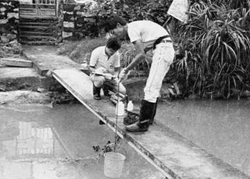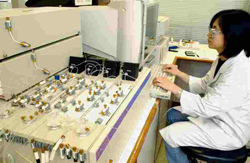Brief historical background
The general background to the setting up of the EPD’s river monitoring
programme was sketched in Chapter 1. This chapter will describe the
programme in more detail, and look at the scientific basis that
underpins the collection of water samples and the testing strategies
used.
On being established in 1986, the EPD took on
the responsibility of monitoring river water quality. A number of
clear objectives lay behind the establishment of the river water
quality monitoring programme. Part of the programme’s role was to
provide ongoing snapshots of the condition of Hong Kong’s most
important rivers. As time went on, these snapshots would build up
into a cumulative picture of long-term changes in water quality. The
information thus provided would constitute the data against which
the Government could assess the effectiveness of any pollution
abatement measures that were introduced, as well as check compliance
with the statutory Water Quality Objectives (as they were drawn up
for each Water Control Zone). Another important role envisioned for
the data provided by the programme was as a basis for planning
future strategies for controlling pollution.
 |
A river monitoring station in Tai Chung Hau Stream set up in 1986 |
|
The river water quality
monitoring programme is simple in concept. It consists first of
setting up a number of monitoring stations in rivers and streams
across Hong Kong. These monitoring stations are not pieces of fixed
equipment or buildings, but simply points on rivers that are
accessible and from which EPD staff can take representative water
samples. Once these stations have been selected, EPD personnel make
regular monthly visits to carry out in situ water quality measurements
and to collect water samples for laboratory analysis later on.
Water quality parameters
The EPD’s approach to testing the water of
rivers in the programme is a comprehensive and scientific one. Each
water sample is tested for numerous physical, chemical and
microbiological water quality parameters. When the programme first
started in 1986, water testing included 37 different parameters, and
since then another 11 parameters have been added to make a total of
48.
By a ‘parameter’ is meant one particular
characteristic or property of water. Groups of related parameters
show important general characteristics of the river from which the
sample is taken. For example, the EPD uses six parameters that are
important for getting a general picture of the condition of a river.
They describe the basic physical chemical properties of the water,
namely flow, water temperature, conductivity, dissolved oxygen, pH,
and turbidity.
Three parameters determine the amount of
insoluble materials in the water: total solids, total volatile
solids, and suspended solids.
Organic pollution of river water is measured
by three parameters, namely 5-day biochemical oxygen demand,
chemical oxygen demand, and total organic carbon.
 |
Nutrient parameters being analysed at
the Government laboratory, using a flow injection analyzer
(photograph provided by the Government Laboratory) |
|
Eutrophication is another
potential form of river water pollution. It refers to the process
whereby rivers receive excess nutrients (e.g. from sewage, livestock
waste or fertilisers) which stimulate excessive plant growth in the
form of algae or weeds. This in turn reduces oxygen in the water and
affects aquatic life. The potential for river eutrophication was
originally measured by seven nutrient parameters: ammonia-nitrogen,
nitrite-nitrogen, nitrate-nitrogen, total Kjeldahl nitrogen, ortho-phosphate,
total phosphorus, and silica. More recently, in 2001, two further
parameters relating to eutrophication were added. These are the plant
pigment parameters of chlorophyll-a and Pheo-pigment.
Industrial pollution has been a problem in
certain areas of Hong Kong, and 12 parameters relating to metals and
metalloids were initially used in 1986 to measure the degree of such
pollution. These parameters are aluminium, arsenic, boron, cadmium,
chromium, copper, iron, mercury, manganese, nickel, lead, and zinc. In
1997, another seven were added (antimony, barium, beryllium,
molybdenum, silver, thallium, and vanadium), making a total of 19. In
addition, another four parameters closely connected with industrial
and commercial pollution are used, measuring total cyanide, fluoride,
oil and grease, and detergent.
Water pollution can bring with it unpleasant
smells which are often due to oxygen depletion, and two parameters
measure the chemicals that produce the odour associated with
pollution. They are sulphide and free hydrogen sulphide.
From 1989, selected monitoring stations also
monitored E. coli and faecal coliforms, which indicate faecal
contamination from domestic sewage and animal waste. These two
bacterial parameters were extended to all stations from 1999.
Data relating to faecal coliforms and E. coli
in this report is presented in the form of annual geometric mean
figures, while data on the other 46 water quality parameters is
presented in the form of annual median figures.
The Water Quality Index (WQI)
Each of the 48 parameters discussed above is important and has its own
story to tell. Together they provide a detailed picture of river water
quality, but this can be somewhat complex for the general public to
understand. To make it easier to get a picture of general river water
quality, the EPD has also adopted a simple Water Quality Index (WQI).
Developed by the Ministry of Transport and Public Works in The
Netherlands, the WQI uses just three key parameters to create a simple
and clear way of measuring a river’s level of organic pollution and
its ability to support aquatic life.
 |
|
 |
|
| How the Water Quality Index is calculated |
|
|
No. of points awarded |
DO
(%saturation) |
BOD5
(mg/L) |
NH3-N
(mg/L) |
1 |
91 – 110 |
< 3 |
< 0.5 |
2 |
71 – 90
111 – 120 |
3.1 – 6.0 |
0.5 – 1.0 |
3 |
51 – 70
121 – 130 |
6.1 – 9.0 |
1.1 – 2.0 |
4 |
31 – 50 |
9.1 – 15.0 |
2.1 – 5.0 |
5 |
< 30 or > 130 |
> 15.0 |
> 5.0 |
|
 |
|
 |
These three parameters are
dissolved oxygen (DO), 5-day biochemical oxygen demand (BOD5), and
ammonia-nitrogen (NH3-N) content. Points are awarded for each
parameter as can be seen from the accompanying table: the better the
results for each parameter, the fewer the points awarded. For example,
a river that had a DO of 91% saturation or above, a BOD5 reading of
less than 3, and less than 0.5 mg per litre of NH3-N, would receive
three points. A river at the other end of the scale would receive 15
points.
 |
|
 |
|
| How the Water Quality Index is graded |
|
|
Water Quality Index |
Water quality condition |
3.0 – 4.5 |
Excellent |
4.6 – 7.5 |
Good |
7.6 – 10.5 |
Fair |
10.6 – 13.5 |
Bad |
13.6 – 15.0 |
Very Bad |
|
 |
|
 |
The WQI of a particular river
monitoring station can be expressed as both a monthly and an annual
figure. The monthly figure is simply obtained by adding up the points
gained from the three parameters after the monthly sampling and
testing has taken place. The annual WQI is obtained by averaging out
all the monthly WQI for the year. In both cases the points total is
then given an evaluative label, as the accompanying chart shows, which
may range from ‘Excellent’ to ‘Very Bad’.
Compliance with the Water Quality Objectives (WQOs)
Another way in which the EPD analyses and presents data from its water
monitoring programme is to express the level of compliance with the
statutory Water Quality Objectives (WQOs). These WQOs are specific
objectives laid out in the Water Pollution Control Ordinance (see
Chapter 1). They specify the long-term water quality goals that the
Government is to achieve and maintain for individual rivers in Hong
Kong. Each river has a slightly different set of WQOs, specific to its
particular characteristics and beneficial uses.
This report presents the annual average
compliance with key WQOs of each individual river. The parameters used
for calculating WQO compliance include pH, suspended solids, dissolved
oxygen, 5-day biochemical oxygen demand, and chemical oxygen demand.
In addition to the compliance data for individual rivers, the EPD also
calculates an overall compliance figure for all of Hong Kong.
Compliance with the WQOs is expressed as a
percentage, with 100% indicating full compliance. These annual
compliance percentages are based on results of all samples taken from
an individual monitoring station throughout the year. For example, if
all samples from a monitoring station taken through the year meet the
WQO for dissolved oxygen, then its WQO compliance rate will be 100%.
If only half meet that WQO, its compliance rate will be 50%.
Because some rivers have more than one sampling
station, WQO compliance for these rivers is expressed as an average of
the annual compliance rate of all its individual sampling stations. In
the same way, the overall compliance figure for the whole of Hong Kong
is averaged out from all of the sampling stations in the territory.
Long-term water quality trends
A further scientific approach to sampling work taken by the EPD
relates to the analysis of long-term water quality trends. The EPD
uses certain proven statistical tools to highlight and assess trends
in water quality over longer periods. The non-parametric Seasonal
Kendall Test used by the EPD is based on ten or more years of
monitoring data. When correctly applied, it gives an accurate
indication of whether river water quality parameters at each
monitoring station show statistically significant increases or
decreases, or whether no trends have developed.
Pollution load reduction
A final method used by the EPD to assess improvements in water quality
is known as ‘pollution load reduction’. This method measures the
reduction over time in the overall organic pollution load in a given
river catchment area, expressed in terms of kilograms of biochemical
oxygen demand per day (kg BOD/day). |